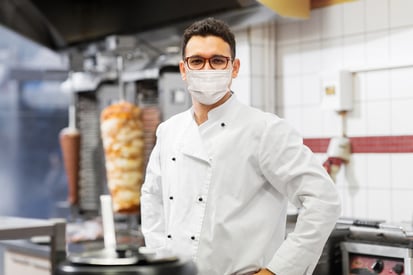Restaurants everywhere were making their operations more sustainable — and then the COVID pandemic struck. Takeout took over, resulting in an avalanche of individually wrapped plastic cutlery, straws and disposable containers. Concerns about single-use plastic and food waste were eclipsed by the fear of germs.
But waste-reduction efforts can’t be abandoned, advocates say; they just need to adapt. Prior to the pandemic, one-third of consumers were actively trying to reduce their consumption of single-use plastics, says Nell Fry, Sodexo’s senior manager of sustainability. The threat of pollution and climate change has only temporarily been eclipsed, she says; “As soon as we have  this pandemic under control, there’s going to be this whiplash… ‘What are you doing about plastics? We want this done yesterday.’”
this pandemic under control, there’s going to be this whiplash… ‘What are you doing about plastics? We want this done yesterday.’”
Safety and sustainability don’t have to be at odds. We’ll look at a few ways restaurants and other foodservice operators are maintaining their commitment to green operations while adapting to the realities of business during COVID-19.
They’re re-examining reusable programs.
Shifting to 100% disposable food containers and cutlery isn’t a workable option for many foodservice operators. “This is a cost problem for a lot of our sites,” says Fry, as universities and senior living communities that offered mainly sit-down service now “have this ginormous paper cost that they suddenly have to absorb.” Sodexo is working with those operators to figure out how to return to using reusable dishes and cutlery and assure diners that they’re safe.
“We are working to ideate creative ideas to utilize a reusable container system and still maintain track of it, so that students return a dirty empty container and pick up a clean one on their next visit,” Jennifer Byrdsong, vice president of operations for Compass Group at Northwestern University, tells Foodservice Director.
Experimental reusable-container programs such as Vessel (exchangeable stainless-steel tumblers) and GoBox (durable takeout containers) are seeking to resume operations in Berkeley, Calif. and Portland, Ore., respectively. The challenge, these companies admit, is educating and reassuring customers that sanitized reusables are just as safe as disposables. Upstream Solutions offers a resource guide to help restaurants make the case.
One simple, proven way to reduce costs and plastic waste: Give customers the option to say no. As part of the online order process, allow them to opt out of plastic utensils. By doing this, the Just Salad chain saved money and reduced utensil use on takeout/delivery orders by 88%, CNBC reports.
Reducing food waste
COVID-19 pushed food-waste reduction to the top of operators’ priority lists, but it also made it more difficult to achieve efficiency. LeanPath research shows that when foodservice volume decreases, food waste increases (relative to food purchased). “When this low-volume/high-FER [food efficiency ratio] reality is coupled with other reopening challenges — executing new menus, planning with no historic data to guide production levels, and changing customer expectations — it will be easy for operators to see a dramatic increase in food waste,” LeanPath warns.
One way to cut costs and waste is to reinvent the menu. “The best way for smaller-volume operations to lower their FER is to have a simple menu that allows for as much cross-utilization of ingredients as possible and builds in opportunities for daily specials to repurpose overproduction,” advises LeanPath Executive Chef Robb White. Hamilton Beach Commercial kitchen equipment helps chefs make it happen.
For more ideas, check out our previous post "Five Ways Restaurants Can Stretch Food Budgets Further", which includes these suggestions:
- The PrimaVac™ line of vacuum chamber sealers prevents waste by keeping fresh food fresher longer and frozen food in perfect condition. Because oxygen is excluded and moisture is retained, vacuum-packed food keeps significantly longer than food that’s conventionally packaged. (Operators must adhere to food safety guidelines and train staff in safe handling practices when using vacuum packaging.) The PrimaVacTM can even bring wilted greens and herbs back to life — find out how!
- The EXPEDITOR™ Family of Culinary Blenders, with powerful precision and durable construction, transforms extra ingredients into anything you desire: salsa, soup, coulis, relish, sandwich spread, chimichurri… Slash food waste — and food costs — by using your culinary blender creatively.
- otto™ the Juice Extractor is a sturdy kitchen workhorse that’s optimized to maximize flavor and juice yield from a variety of fruits and vegetables. Turn excess produce into profit by adding fresh juice to the menu.
Discover more foodservice innovations from Hamilton Beach Commercial.


